Tucson Water in Tucson, Arizona, USA has a service area that includes more than 4,600 miles (7,400 km) of pipe, 142 transfer valves, more than 21,000 hydrants, 88,000 flow valves, and much more. In 1999, one of the utility’s 96-inch (243.8 cm) prestressed concrete cylinder pipes (PCPs) failed. The sudden release of water included approximately 38 million gallons (143.8 million L) out of a 60-million-gallon (227.1 million L) reservoir. This one failure cost the city well over $5 million in repairs, homes, vehicles, and, of course, getting the affected roadways back to their original nature.
This failure is also where Tucson Water’s Pipeline Protection Program began. When the failure occurred, Paul Acosta, quality control manager, and his team at Tucson Water were in a hurry to figure out what their next steps would be. This article details the failure, the remedial actions, and the proactive approach they’ve taken since.
The 1999 Failure
Figure 1 illustrates the components of a PCP. The integrity of this type of pipe lies largely in the prestressed wire. The prestressed wire is stressed to 75% of its ultimate tensile strength, meaning that it leaves no tolerance for corrosion, which is important in the watertightness of the steel cylinder within.
When a failure occurs on a prestressed pipe, most commonly, the mortar coating cracks, and then moisture migrates through, thereby corroding the wire. Eventually, the water pressure overwhelms this weak point, and a failure occurs.
Along with the failure of the 96-inch pipe, a 72-inch (182.9 cm) valve also failed. Crews were en route to try to isolate the main. They had a hydraulic actuator that they put onto the valve stem and attempted to close the valve. As the crew was closing it, there was a sudden release of water. The top portion of the disc failed, went downstream, did “Morse code” on the inside of the 96-inch pipe, and was ejected out the hole that had opened up.
Although this is an example of a typical failure of a PCP, it was time for Tucson Water to find out why it happened and what they could have done differently.
Inventory and Assessment
Acosta has a saying: “You get what you inspect, not what you expect.” Tucson Water immediately took a proactive approach, taking inventory of its major pipelines to prepare for inspections and condition assessments. All of the utility’s means of transmission were included, as shown in Figure 2. The Pipeline Protection Program was under way.
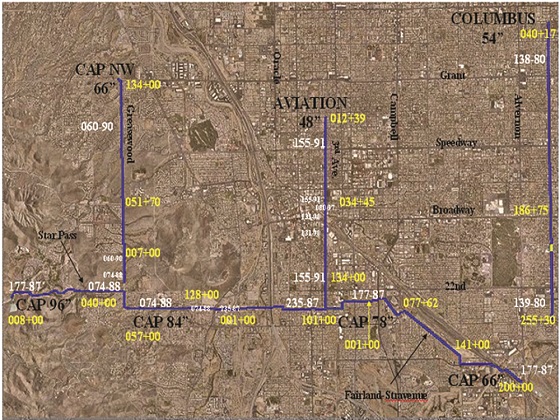
It started with regular visual and sounding inspections, but the program has since advanced to utilizing some of the latest technologies available—for example, electromagnetics. Electromagnetic testing allows for the detection of broken wire zones in PCP, including the number of broken wires in that zone. An example of electromagnetic test results is shown in Figure 3.
Tucson Water uses electromagnetic testing capabilities from Pure Technologies Inc. (PTI). In one instance, PTI told Tucson Water that there were 30 broken wires on the 66-inch (167.6 cm) main. Tucson Water inspected it and found an area with 16 broken wires. The technology worked at this location.
In another instance, it was shared that there were 50 broken wires on a 54-inch (137.2 cm) pipe. Tucson Water dug it up. The mortar was intact. However, it was discovered that, when the original manufacturer ran out of wire or the wire actually broke during pipe production, it was corrected with a splice before the pipe wrap continued. This caused the detection of broken wires in that area.
As can be seen from these two instances, the technology doesn’t always work, but it’s still an important tool in one’s arsenal.
The water utility is also using fiber-optic acoustic monitoring. All of the department’s pipelines now have acoustic monitoring connected to a data acquisition system. A fiber-optic cable is installed at the pipe inverts (the “floor” level of the pipes), and a laser shoots light down the fiber. The sound from a wire break creates a pressure wave, which distorts the fiber’s diameter. This distortion causes the laser’s light to reflect back, which is then measured and converted into an electrical signal and is read as acoustic information. When the data is analyzed, the location of each wire break is revealed.
Tucson Water also uses the services of Simpson, Gumpertz, and Heger (SG&H). They perform finite element analysis on the pipelines and provide risk failure curves. This enables the water department to prioritize the various risks involved to better manage the pipelines.
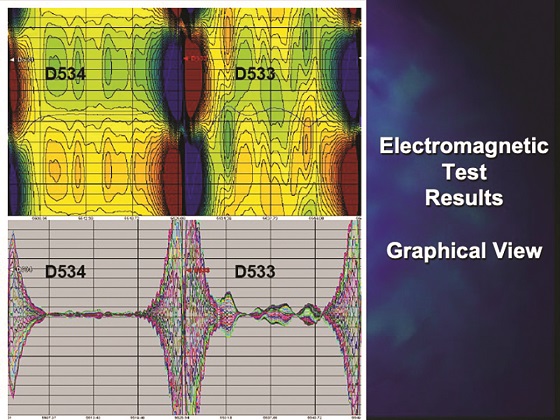
Corrosion Control
Side by side with condition assessment of pipelines is corrosion control. All pipeline owners and users know that corrosion control is essential.
The first line of defense against corrosion is typically a coating or a lining, whether it’s sprayed on or it’s a polyethylene encasement. Tucson Water also utilizes impressed cathodic protection (CP) systems, deep well anode systems, as well as sacrificial systems.
Let’s look at a particular case where corrosion control has helped Tucson Water.
Back in 2006, electromagnetics revealed that, on a 78-inch (198.1 cm) PCP main, there were multiple locations of broken wires and zones with 20 or more breaks. Acoustic monitoring also revealed that the pipeline was active, i.e., wires continued to break.
PEAK Corrosion, a local Tucson-area contractor, came in to perform a close interval potential survey. The pipe-to-soil levels were in the range of 400 millivolts, which is indicative of possible corrosion on the pipe.
An impressed CP system was installed on this 78-inch PCP, and to date, the department has yet to experience any more acoustic wire events on this main. The CP system is protecting the pipeline.
Every one of Tucson Water’s pipelines has a corrosion monitoring test station installed, typically every 1,000 feet (304.8 m). Other pipelines that are cathodically protected include the department’s 66-inch, 54-inch, and 48-inch (121.9 cm) pipelines. So far, there have not been any acoustic events on these pipelines, meaning that there are no broken wires. And the electromagnetics show very little distress, indicating that the wires on the PCPs are largely inactive.
However, there is one particular section of pipe that is active acoustically. This area has what is known as “black pipe.” It’s originally from Ameron and has an epoxy coating. With that type of coating, the current demand goes way down, and the level of CP required is much lower.
The 2012 Failure
In 2012, Tucson Water had another 96-inch pipe failure. This time, there was no sudden release of water. Emails alerted Acosta that a wire break had occurred, what pipe number it was, and how many wires had broken. He immediately requested that the reservoir and the 96-inch be isolated. After analyzing the data, it was obvious that the pipe was going to fail—not if, but when. A subsequent excavation showed that this pipe already had a huge amount of structural damage and was bulging (Figure 4). “It was so bad that I was able to reach my hand into the failed outer core and touch the steel cylinder,” Acosta recalls.
During the 2012 outage for this 96-inch pipe, the department continued its inspection downstream. SG&H also modeled an 84-inch pipe at this time and found that the wires were having issues. However, they saw more serious issues going on downstream. The Tucson Water team went back into the pipe to further investigate and inspect the pipe. They found nothing. Acosta ordered destructive inspections. “We chipped out the pipe, chipped out the joint, and without a doubt, the steel cylinder had torn away at the joint,” says Acosta. “It was a great catch.”
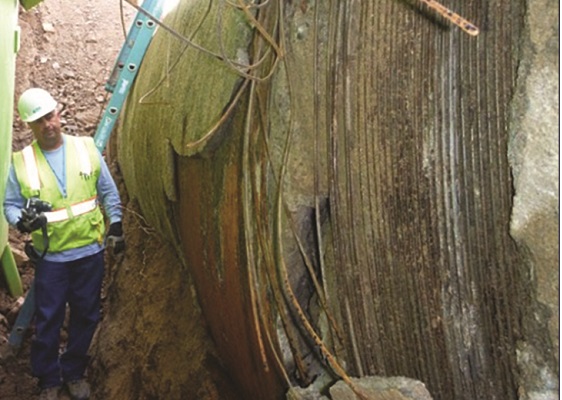
Taking Things Further
Acosta says he uses the acoustic monitoring and data acquisition system because “it’s obvious. When you look at a [bulging] pipe like this, there had to have been huge acoustic events” leading up to it.
“A noisy pipe is a bad pipe,” continues Acosta. “We want to utilize the acoustic monitoring, the data acquisition system, and try to capture these events of interest.” When a lot of acoustic events are captured in a particular location, the team is directed to perform further inspection. Acosta says, “We started finding that they were cracked, and there was a leak on rotated bends. You could see the cracks. We prevented more failures again.”
Tucson Water is also moving in the direction of pipe repair and pipe renewal whenever possible, including carbon fiber reinforced polymer (CFRP). According to Acosta, “There’s a lot of great companies out there. One that we definitely use is Structural Technologies.”
There is also electrical continuity to be considered. Before performing an outage on a pipeline, it’s important to know what’s going on, electrically speaking, on that pipeline. If corrosion test stations are installed every so many feet, span resistance tests can be performed. These tests determine whether there is electrical continuity between pipe segments. If that continuity is broken, it’s important to renew that joint and the bonds. Tucson Water utilizes a pin brazer to correct these types of electrical discontinuities between pipe segments.
Know Before You CP
There is some debate over using cathodic protection on PCP systems. However, it’s important to test a pipeline first. Acosta advises, “If you ever perform an external validation or inspection and you have access to your wire and the mortar, send it to a lab to get it tested. They’ll do a torsion test. They’ll do all the tests possible so you’ll know immediately whether you can cathodically protect it.”
As an example, Tucson Water had two segments in opposite corners of a 54-inch line that had already been renewed by CFRP. The pipe was extremely active, and wire breaks were frequent both prior to and after cathodic protection. What was happening? The cathodic protection was, in fact, producing hydrogen embrittlement on the wires, which essentially created more problems. The embrittlement is shown in Figure 5.
Since then, the CP on that line has been de-energized. But it was also found that the wire itself was of poor quality, and it couldn’t even pass a split voltage test. “Therefore, make sure you run tests prior to installing a CP system on a prestressed line,” Acosta says.
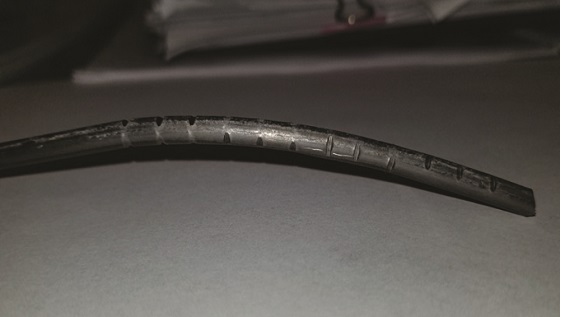
Additional Technologies
What further technologies are available to water utilities? Tucson Water’s Pipeline Protection Program is certainly using a variety of them.
One is transient pressure sensors to monitor any surges that occur in the mains. The sensors are used when a pipe is getting ready to be isolated and dewatered.
Accurate Corrosion Control, Inc., out of Phoenix, Arizona, has produced a rotocell that helps identify hotspots, whether it’s stray current interference or just to check the levels of potentials. No matter what the outdoor temperature, the test can be performed comfortably from inside a vehicle (see Figure 6).
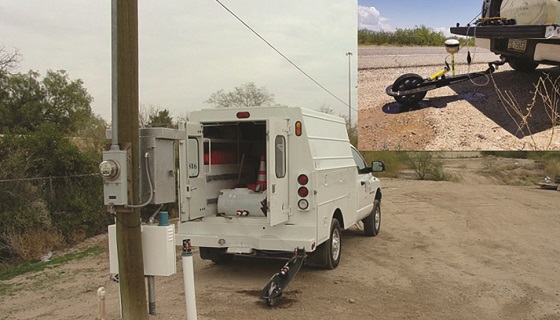
Also in use at Tucson Water is the ABEM Terrameter, which is used for pipeline span resistance tests, soil resistivity tests, and circuit resistance measurements. Acosta indicates he is all about collecting more and more data for analysis and is willing to try all the tools at his disposal.
Leak detection is another method, and for this, the department is utilizing the SmartBall from Xylem. The SmartBall provides the location of a leak, especially if the pipeline has a good, straight run and there are no laterals. Acosta further comments, “I intend to use more of [PTI’s] Sahara, and I’m even going to entertain the Electro Scan. I’m in talks with them for leak detection.”
Finally, the utility uses its break history to create heat maps; artificial intelligence with VODA Infracta; plus men and women who serve as “locators” to mark leaks. “We get them the tools that they need to try to eliminate mismarks from the GPR [ground-penetrating radar] to the GPS locating,” Acosta says. “They’re getting very proficient at using this GPR. It’s really impressive, what they do.”
Conclusion
With all these technologies at the ready, the Tucson Water Pipeline Protection Program is evidently working, not only at identifying potential failures but also at preventing them. This is indeed an approach from which other water departments and utilities could benefit.
Editor’s Note: This article is based on a Materials Performance webcast with the same title. It was broadcast in February 2021 and can be viewed on demand at no charge at materialsperformance.com/webinars.